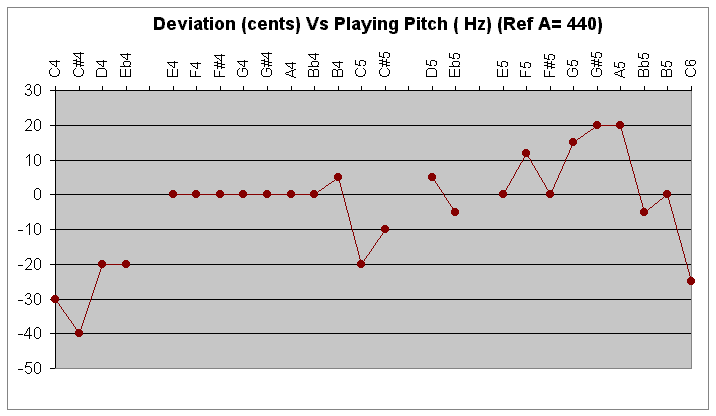Playing qualities
With the flute in less than full repair, it was difficult to gain a
full appreciation of the instrument's playing qualities. But on
the rare moments one could convince the inappropriate pads to seat
adequately it showed real class. I look forward to an opportunity
to try it again when the pads are replaced.
Intonation
Being away from home meant I haven't been able to put my full
resources into establishing the tuning characteristics of #519. In
addition, leakage through the ill-fitting pads rendered the low notes
less than reliable. But a quick check with a portable tuning meter
suggests a very acceptable result in the A440 region. The low
octave is essentially in excellent tune apart from a slightly flat upper
c note, which also affects c#. The second octave tends a bit sharp
in the G to A region, probably suggesting that 440 is not quite its best
pitch - not altogether surprising given the period. The C6 shown
is using the key - a better result is probably available on the
cross-fingering. It reflects the flatness of C5. The mid
foot-notes, D5 and Eb5 are well placed to bridge the gap between the
first two octaves.

Flat foot?
Now on flutes from that period one expects to find a very flat foot -
notes between C4 and D4 up to 60 cents flat of the low octave
notes. But we notice they are flat, but not that flat. Close
inspection of the tenon of the right hand section suggests that the
section may have been shortened to reduce flat foot. Yet, if so,
it would make it originally longer than others I have data for. I
couldn't tell for sure and by how much without removing the thread
lapping - this is something that will have to await a better
opportunity.
Third octave?
Again, time meant I couldn't explore the third octave in depth.
But enough to say I could play up to C7 (C'''' in flute terms), an
impressive range for this period.
Conclusions and Acknowledgements
A lovely flute all round, illustrating why Rudall & Rose so
quickly and thoroughly came to prominence in the 1820's.
A thank-you to flute owner, Rob Boyle, for letting me measure and
photograph the flute and publish this page. A further thank-you to
Melbourne flute player Andrew Le Blanc for making the connection.
Back to McGee-Flutes
Home Page Created 2002 (?). Reformatted 2018
|